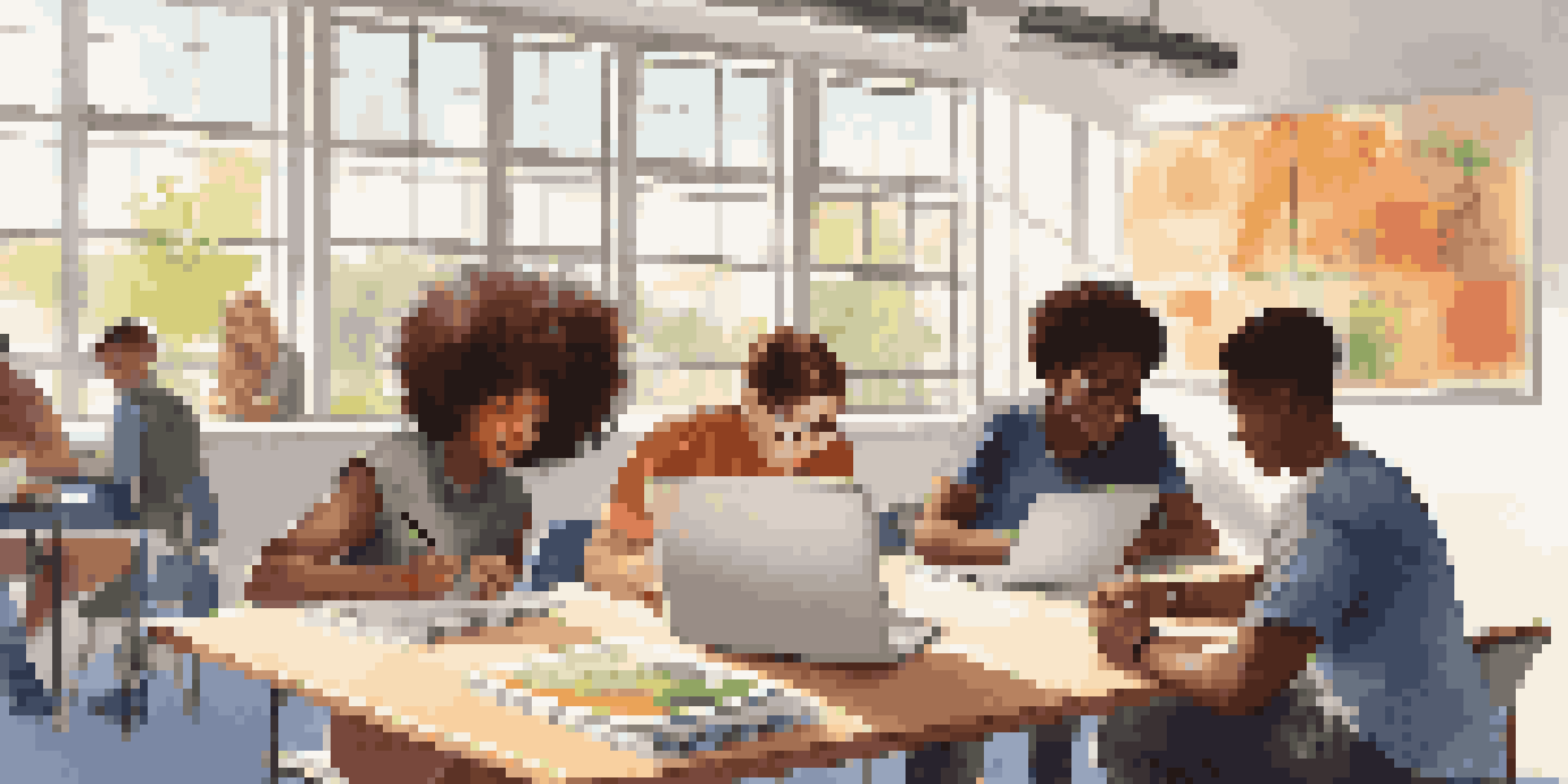Using Social Media Platforms to Enhance Student Collaboration

The Role of Social Media in Modern Education
Social media has become an integral part of our daily lives, and its influence extends into the classroom. Platforms like Facebook, Twitter, and Instagram provide students with unique opportunities to connect with peers beyond traditional settings. This connectivity fosters not only friendships but also collaborative learning experiences that enhance educational outcomes.
The great thing about social media is that it gives everyone a voice and a platform to share their thoughts and ideas.
For instance, students can form study groups on Facebook, sharing resources and insights in real-time. This collaborative environment encourages teamwork and communication skills, which are essential for success in both academic and professional settings. By leveraging social media, students can break down geographical barriers and collaborate with classmates around the globe.
Moreover, these platforms allow for a more relaxed atmosphere for discussion, making it easier for students to express their thoughts and ideas. This open dialogue can lead to a deeper understanding of complex subjects, as students learn from each other's perspectives and experiences.
Choosing the Right Social Media Platforms
Not all social media platforms serve the same purpose, so it’s crucial for students to choose wisely. For collaborative projects, platforms like Slack or Microsoft Teams can be more effective than Instagram or Snapchat, as they offer tools specifically designed for communication and project management. Understanding the strengths of each platform can significantly enhance the collaborative experience.

For example, Google Docs allows multiple users to edit documents simultaneously, making it a great choice for group assignments. In contrast, platforms like Twitter can facilitate quick discussions and updates about ongoing projects, keeping everyone in the loop. Each platform has its unique features that can cater to different aspects of collaboration.
Social Media Enhances Learning
Platforms like Facebook and Slack foster collaboration among students, improving communication and teamwork skills.
Encouraging students to explore and experiment with various platforms can help them find the best fit for their needs. This exploration not only aids in their current projects but also equips them with valuable skills they can utilize in future collaborative endeavors.
Creating Collaborative Study Groups Online
Establishing online study groups is a fantastic way to leverage social media for collaboration. Students can create dedicated groups on platforms like Facebook or WhatsApp, where they can share notes, ask questions, and provide support to one another. This sense of community can boost motivation and enhance learning outcomes.
Collaboration allows us to know more than we are capable of knowing by ourselves.
For example, a group of students studying for a chemistry exam can share study materials, quiz each other, and discuss challenging concepts in real time. This interactive approach makes studying more engaging and less isolating, as students feel they are part of a collective effort.
Additionally, these groups can serve as a space for accountability, where members encourage each other to stay on track with their studies. By fostering a collaborative environment, students can enhance their understanding of the material while also building valuable social connections.
Utilizing Video Conferencing Tools for Collaboration
Video conferencing tools have revolutionized the way students collaborate, especially in remote learning environments. Platforms like Zoom, Microsoft Teams, and Google Meet allow students to connect face-to-face, making discussions more dynamic and personal. This visual interaction can enhance engagement and deepen understanding.
Imagine a group project where students are separated by miles but can still brainstorm ideas together in real time through a video call. This immediacy mimics in-person collaboration, allowing for spontaneous brainstorming sessions and immediate feedback, which are crucial for creative processes.
Choose Platforms Wisely
Selecting the right social media tools, such as Google Docs for document editing or Trello for project management, can significantly enhance group collaboration.
Furthermore, these tools often come with features like screen sharing and breakout rooms, enabling focused discussions and collaboration on specific tasks. By incorporating video conferencing, students can create a virtual classroom experience that promotes effective teamwork, regardless of their physical locations.
Encouraging Peer Feedback Through Social Media
One of the most powerful aspects of social media is its ability to facilitate peer feedback. Students can share their work on platforms like Instagram or even specialized forums, inviting constructive criticism from their classmates. This feedback loop is essential for personal and academic growth.
For instance, a student working on a creative writing piece can post excerpts on social media, allowing peers to comment and provide insights. This interaction not only helps improve the quality of their work but also fosters a culture of collaboration and support.
Moreover, learning to give and receive feedback is a vital skill that students will carry into their professional lives. By practicing this on social media, they can build confidence and develop a more robust understanding of how to articulate their thoughts effectively and respectfully.
Integrating Social Media into Group Projects
Social media can be a powerful tool for organizing and managing group projects. By using platforms like Trello or Asana, students can assign tasks, set deadlines, and track progress in a visually engaging way. This level of organization helps keep everyone accountable and informed.
For example, a group working on a presentation can use these tools to break down the project into manageable tasks, ensuring that each member knows their responsibilities. This clarity helps prevent overlaps and gaps in work, leading to a smoother collaborative process.
Balance is Key to Productivity
Setting boundaries for social media use helps students avoid distractions and maintain focus on their academic goals.
Moreover, integrating social media into project management can make the experience more enjoyable. Students can share updates, celebrate milestones, and even use fun emojis to keep the mood light, making the hard work feel a bit more like a team effort.
Maintaining a Healthy Balance on Social Media
While social media offers numerous benefits for student collaboration, it’s essential to maintain a healthy balance. Overuse of these platforms can lead to distractions and burnout, ultimately hindering productivity. Encouraging students to set boundaries and prioritize their time is crucial.
For instance, students can designate specific times for social media use, ensuring they focus on their studies during designated hours. This approach allows them to enjoy the benefits of collaboration without falling into the trap of constant notifications and distractions.

Additionally, promoting digital well-being is vital. By teaching students to recognize signs of digital fatigue, they can learn to step back, engage in offline activities, and recharge, ultimately enhancing their ability to collaborate effectively when they return to social media.